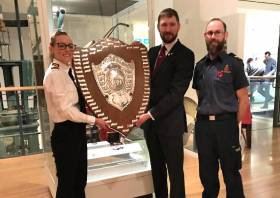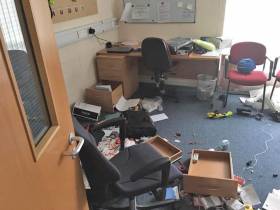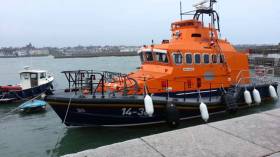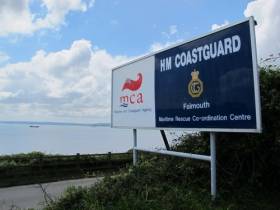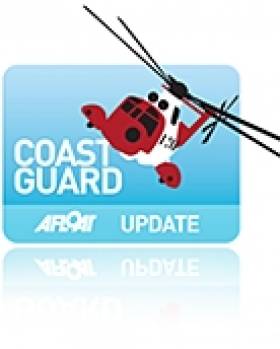Displaying items by tag: HM Coastguard
Rescue Shield Awarded To Shetland-Based Coastguard Teams
HM Coastguard rescue teams from Lerwick, Hillswick and Sumburgh, the search and rescue helicopter crew from Sumburgh and staff from the Coastguard Operations Centre in Shetland have been awarded the prestigious UK Department for Transport Rescue Shield by Brian Johnson, chief executive of the Maritime and Coastguard Agency (MCA), for a dramatic cliff rescue 18 months ago.
The DfT Rescue Shield is the highest national accolade in the United Kingdom awarded to coastguard teams which have performed the most outstanding rescue of the year. The presentation last Tuesday 5 November marks the sixth time that Shetland-based teams have been awarded the shield.
On the evening of 9 May 2018, a teenager was trapped at the base of a 120ft cliff for two hours with the tide coming in, in Fethaland, Shetland, after attempting to scale it.
The rescue was challenging and its success was due to the professionalism and teamwork of all involved in a rescue co-ordinated by HM Coastguard.
Coastguard rescue teams navigated difficult terrain in appalling conditions on the narrow headland, setting up cliff rescue equipment before one of the team descended the cliff, enduring storm force winds, rain and heavy squalls from the incoming tide to safely recover the casualty to the top of the cliff.
“As emergency response teams we rely heavily on each other to achieve success and this case was a prime example of that,” said Dave Sweeney, senior coastal operations officer.
“It was a challenging rescue and we needed all our teams’ shared expertise and resources to safely rescue the man. It was teamwork at its best.
“We are honoured to be awarded for our efforts on this particular rescue and it’s a mark of recognition for all the work and dedication of the front line volunteers, paid crew members and behind the scenes teams that help us all save lives together.”
Coleraine Coastguard is back in business after a reported burglary at its station during Storm Gareth on Tuesday night (12 March).
Volunteers woke yesterday morning (Wednesday 13 March) to find that their station “had been broken into and ransacked”.
The North Coast station was taken offline while the PSNI completely investigations and volunteers could determine that its equipment was safe to use.
Volunteers were given the all-clear by 4.30pm yesterday to resume their rescue services.
And they have appealed for anyone with information about the burglary — one of a spate of incidents throughout the town on Tuesday night — to contact the PSNI.
Donaghadee Kayaker Callout Was ‘Elaborate Hoax’
#Hoax - The UK coastguard has decried an “elaborate hoax” after lifeboats and a coastguard helicopter were launched after several calls from someone claiming to be a kayaker in difficulty off the Co Down coast.
As BBC News reports, lifeboats from Bangor and Donaghadee RNLI respectively joined a rescue helicopter from HM Coastguard in Scotland in the search off the Copeland Islands yesterday (Sunday 2 April) that was declared a hoax after a thorough search of the area.
Dramatic Footage of Coastguard Rescue Teams Rescuing Cragfast Climber in Force 9 Gale
Two Coastguard Rescue Teams carried out a difficult and complex rescue in a Force 9 gale, after a climber became cragfast on cliffs at Fairhead, near Ballycastle, Northern Ireland.
At about 11.30pm yesterday (Tuesday 28 September) the UK Coastguard received a report from a local Coastguard Rescue Team member that a climber needed rescuing after becoming cragfast whilst climbing the cliff.
Ballycastle and Coleraine Coastguard Rescue Teams and Redbay RNLI All Weather Lifeboat were sent to the scene along with the UK Coastguard search and rescue helicopter based at Prestwick. The Northern Ireland Ambulance Service was also informed of the incident.
Daniel McAuley, Station Officer for Ballycastle Coastguard Rescue Team said: ‘The two climbers had started climbing the cliff at around 5.00pm and when the winds started to pick up, the position of the ropes they were using for support moved. Luckily, one of the climbers managed to get the top and raise the alarm at a local farmhouse nearby. The occupants of the farmhouse quickly alerted one of the local Coastguard team members who called the job into the Belfast Coastguard Operations Centre.
‘A combination of working in darkness, the instability of the cliff edge and the 44 knot winds meant that we had to set up thirty metres away from the edge of the cliff to make sure the equipment was secure. We were very grateful to the Belfast Coastguard Operations Centre for co-ordinating the response and for the Coastguard helicopter and the RNLI lifeboat, who shone their lights on the climber and our operations so we could work safely. Without their vital support, our jobs would have been made all the more difficult. This is a great example of how these teams worked brilliantly together under challenging circumstances to rescue the climber. Thankfully, he did not require any medical attention or treatment after being rescued.’
'The climbers did the right thing by calling the Coastguard as soon as they got into difficulty. Unfortunately, they just got caught out by the change in the wind conditions - we're just glad they're safe and well now.'
Plans to make sure there is a full maritime survey and inspection team covering the whole UK, will see more remote working and a slight change to where some of the marine offices are based.
The Maritime & Coastguard Agency has undertaken a review of the way it carries out its surveys and inspections and recently consulted on the locations of its marine offices. It has also, with its staff, reviewed the way the organisation of those offices is structured.
As a result of both consultations, changes have been made to the original proposals including keeping two offices open that were originally marked for closure and identifying a senior experienced marine surveyor who will have over-arching responsibility for the River Thames.
The proposals save more than a third of a million pounds in terms of estate costs.
Belfast, Liverpool, Cardiff Aberdeen, Plymouth, Southampton, Beverley (Hull) and Glasgow Marine Offices will remain open and a new office will be opened in the Colchester/Ipswich area. These will form the main Marine Office hubs.
Dover, Falmouth and Milford Haven will be satellite bases attached to the main marine office hubs from where they will be managed – Southampton, Plymouth and Cardiff respectively.
The Tyne office will close along with Harwich, Norwich and Orpington.
These changes are part of a much larger transformation programme for its survey and inspection business to improve customer service and efficiency. The proposals, which have been approved by the Executive Board of the MCA, will save money with minimal impact on the MCA survey and inspection work force.
Sir Alan Massey, Chief Executive said: ‘This programme marks an exciting moment for the Maritime and Coastguard Agency. The MCA’s marine surveyors are a vital part of our business and have built an outstanding reputation for their technical skills and professionalism. Yet the maritime world is changing, and we have to move with the times.
‘For example, we’ve had great difficulty in recruiting and retaining marine surveyors; and our customers are also - and rightly - demanding more responsive services that are fit for a competitive world market in the digital age. We need to address those things squarely. Modernising our approach, in terms of both the geographical location of our offices and the way our surveyors work, offers us a positive, efficient way forward.
‘We have consulted widely with our staff and external customers in coming to these decisions. The MCA is and remains committed to the highest standards in upholding maritime safety throughout our areas of responsibility: UK-wide and indeed globally. This transformation programme will greatly help us to achieve that.’
Katy Ware, Director of Maritime Safety and Standards and overseeing the plans for the Survey and Inspection Transformation Programme, said: ‘We understand that people might be worried about the future but we have assured both our surveyors and staff that we will continue to work with them as the change programme moves forward. People matter in this Agency and we are committed to making sure we continue to act with that in mind.’
‘We will work with all those staff affected on an individual basis on their transition plans as we will now be carrying on the work with those involved as we work towards implementing this new plan.’
‘I am mindful that we face some testing times ahead. However with the support of our diverse and highly experienced workforce I very much look forward to leading the Directorate of Maritime Safety and Standards as it develops to deliver a service that ensures we meet the expectations of our stakeholders and allows staff to develop themselves.’
Windsurfer Disappears in Foggy Conditions Near Morecambe Bay
#coastguard – HM Coastguard is coordinating a search for a missing windsurfer this evening near the mouth of the River Lune, Lancashire, after receiving a report at 4.30pm that four windsurfers had been out and three had made it back to shore but a fourth man in the group had not.
The windsurfer disappeared in foggy conditions near to the entrance to the River Lune, at the south end of Morecambe Bay. The search involves Knott End and Morecambe Coastguard Rescue Teams, Fleetwood and Morecambe Bay RNLI lifeboats, an RNLI operated hover craft and the rescue helicopter from RAF Valley. Police and mountain rescue have also helped with the search.
The search area now covers a large area including the sand banks between the Lune and Fleetwood.
HM Coastguard Wins GAA Match
The event involves members of the security and emergency services from across Ireland who could find themselves called upon to cope with major incidents or natural disasters. They come together once a year to build relationships through a day of sporting challenge. The informal associations forged at the sports day help to reinforce a team spirit which could one day prove invaluable.
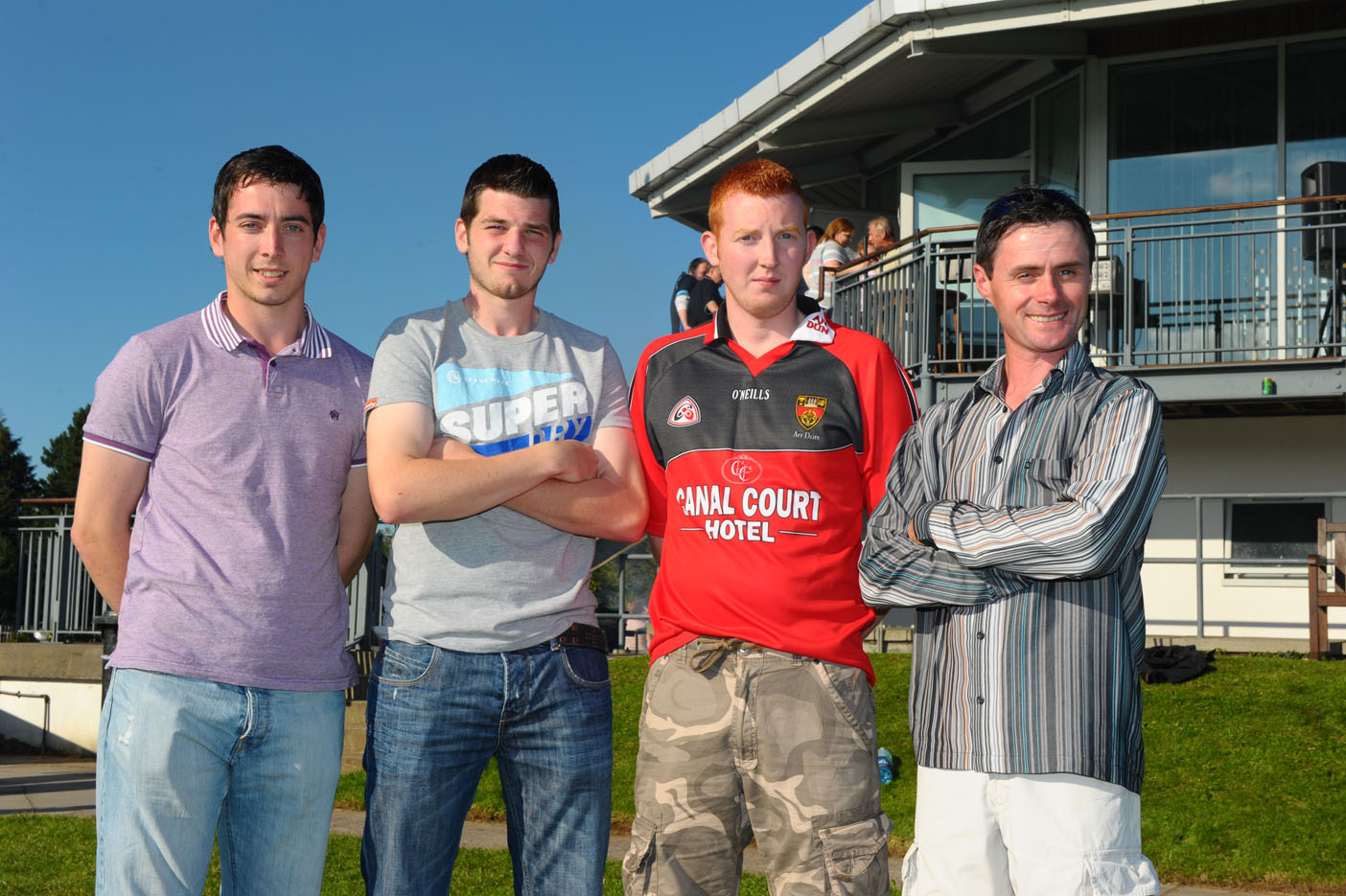
Pictured celebrating their victory in the 7-a-side Gaelic Football competition are members of Team Coastguard, from left, Conor McCombe, Ciaran McCann, Jonty Addis and John Lowry, all from County Down


























